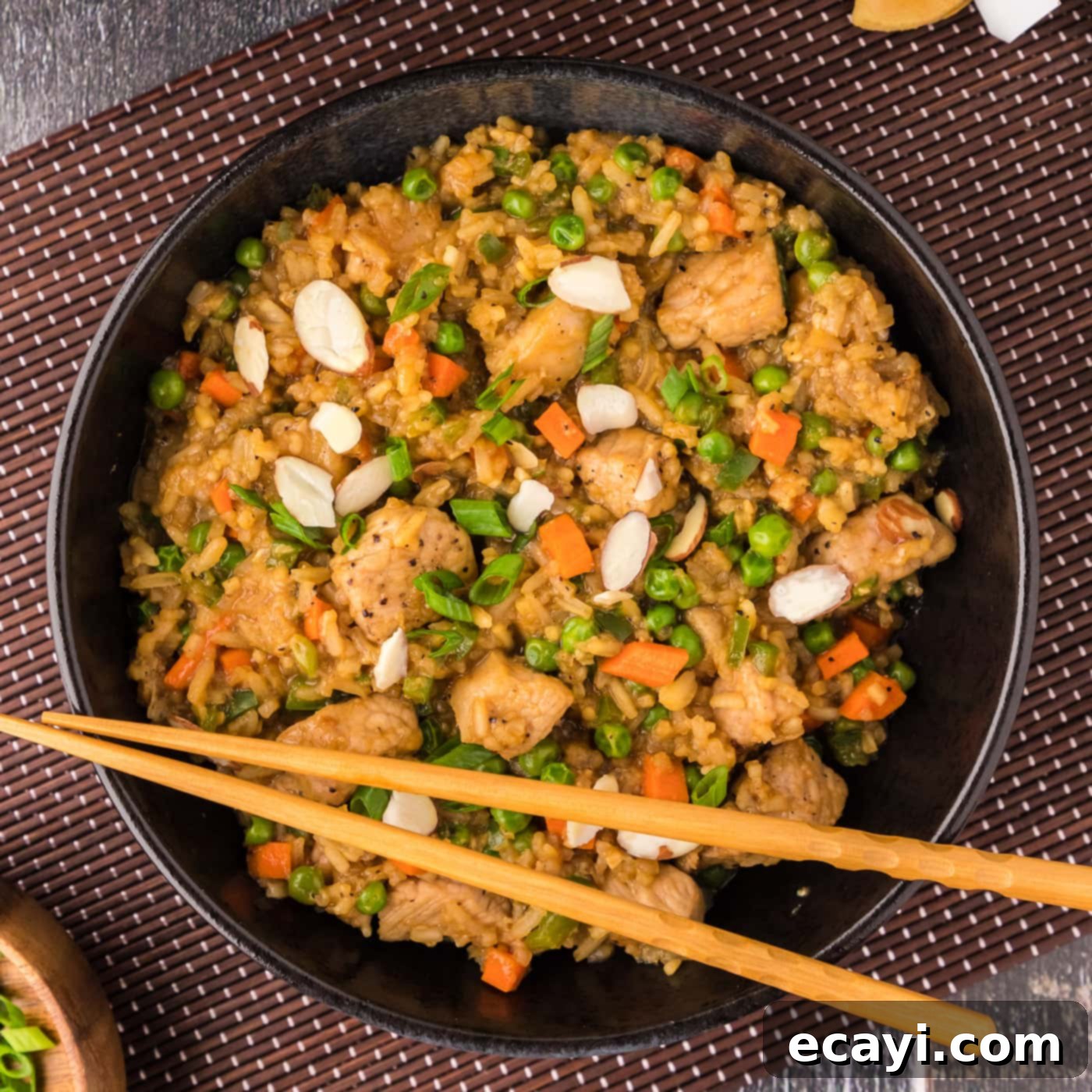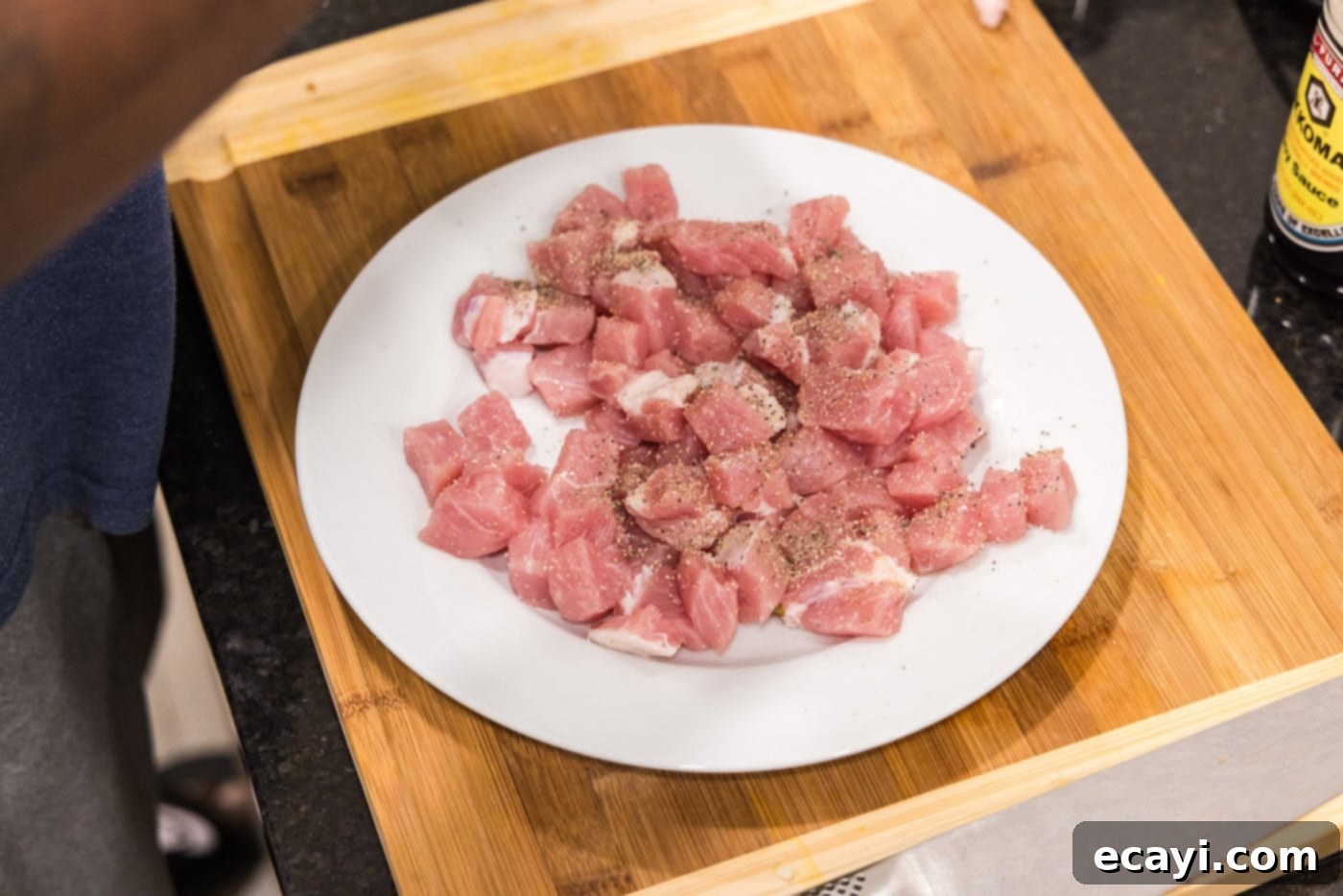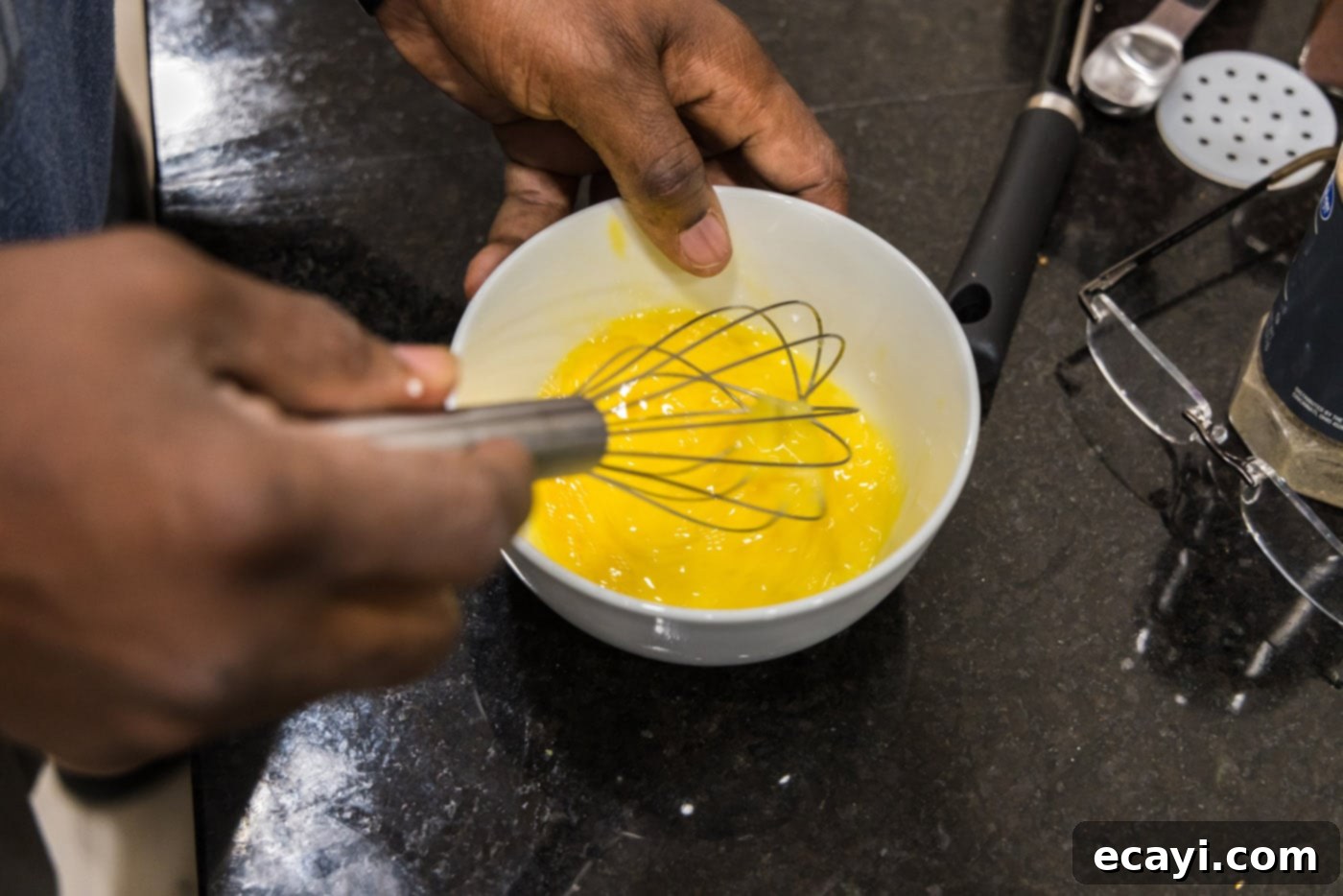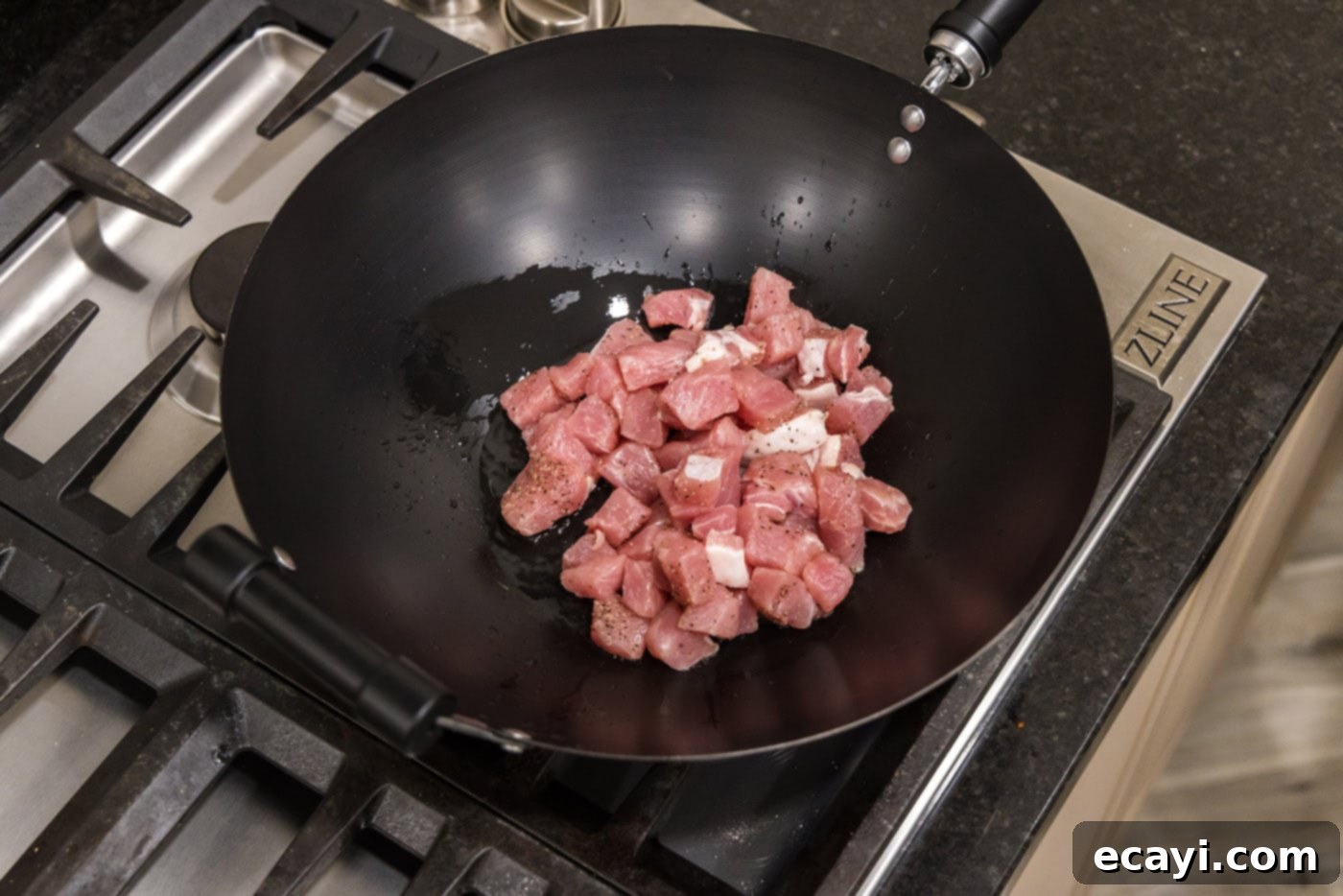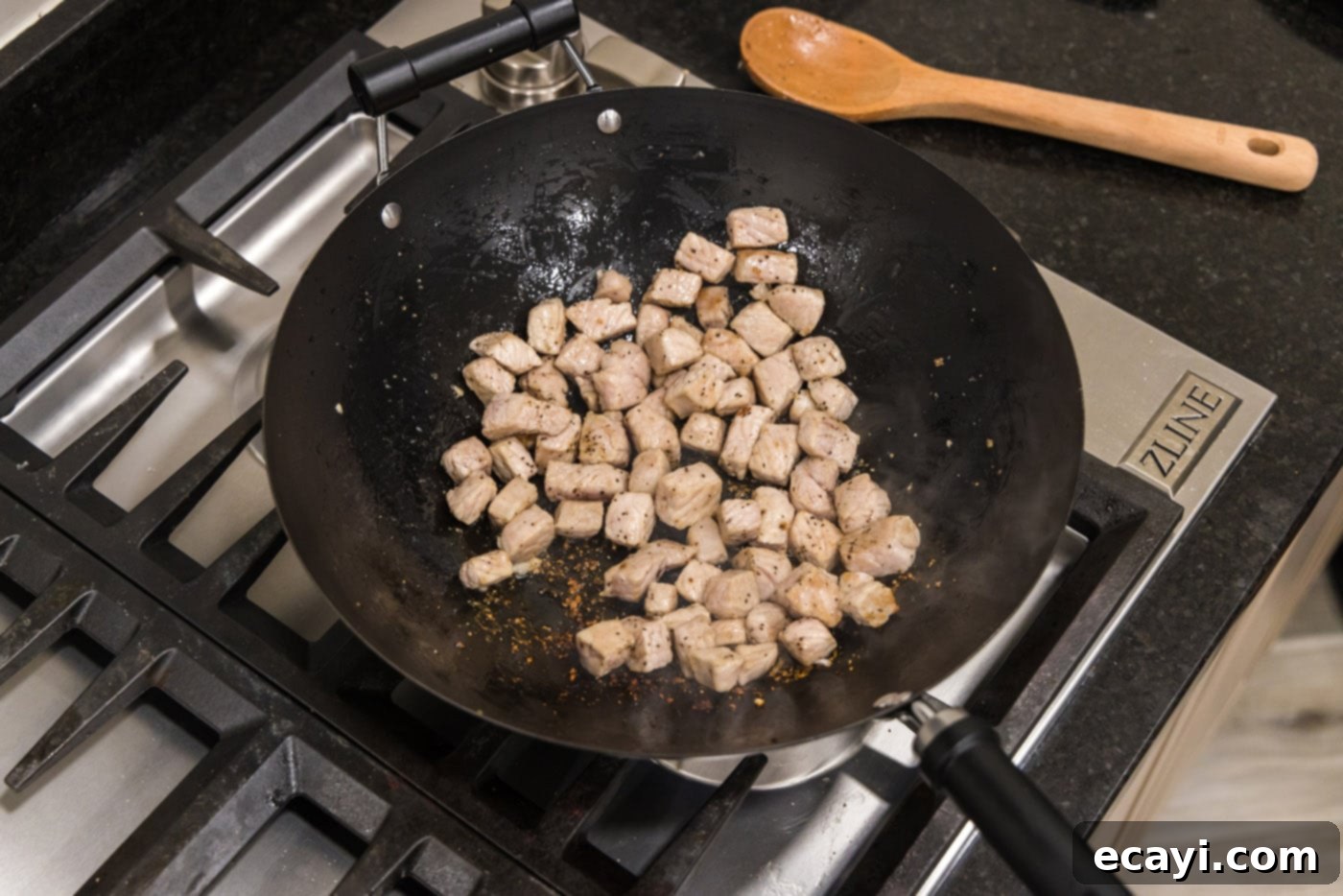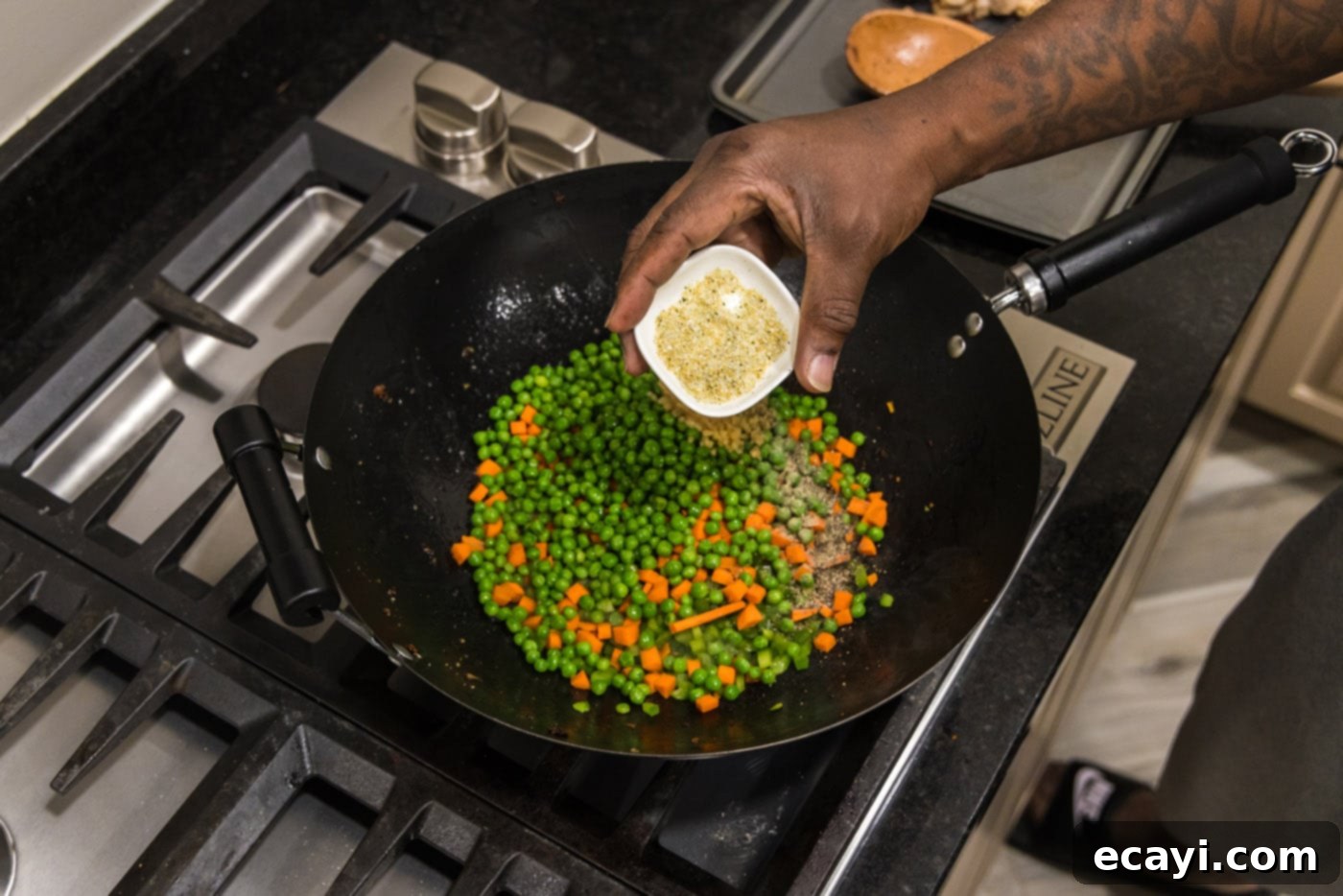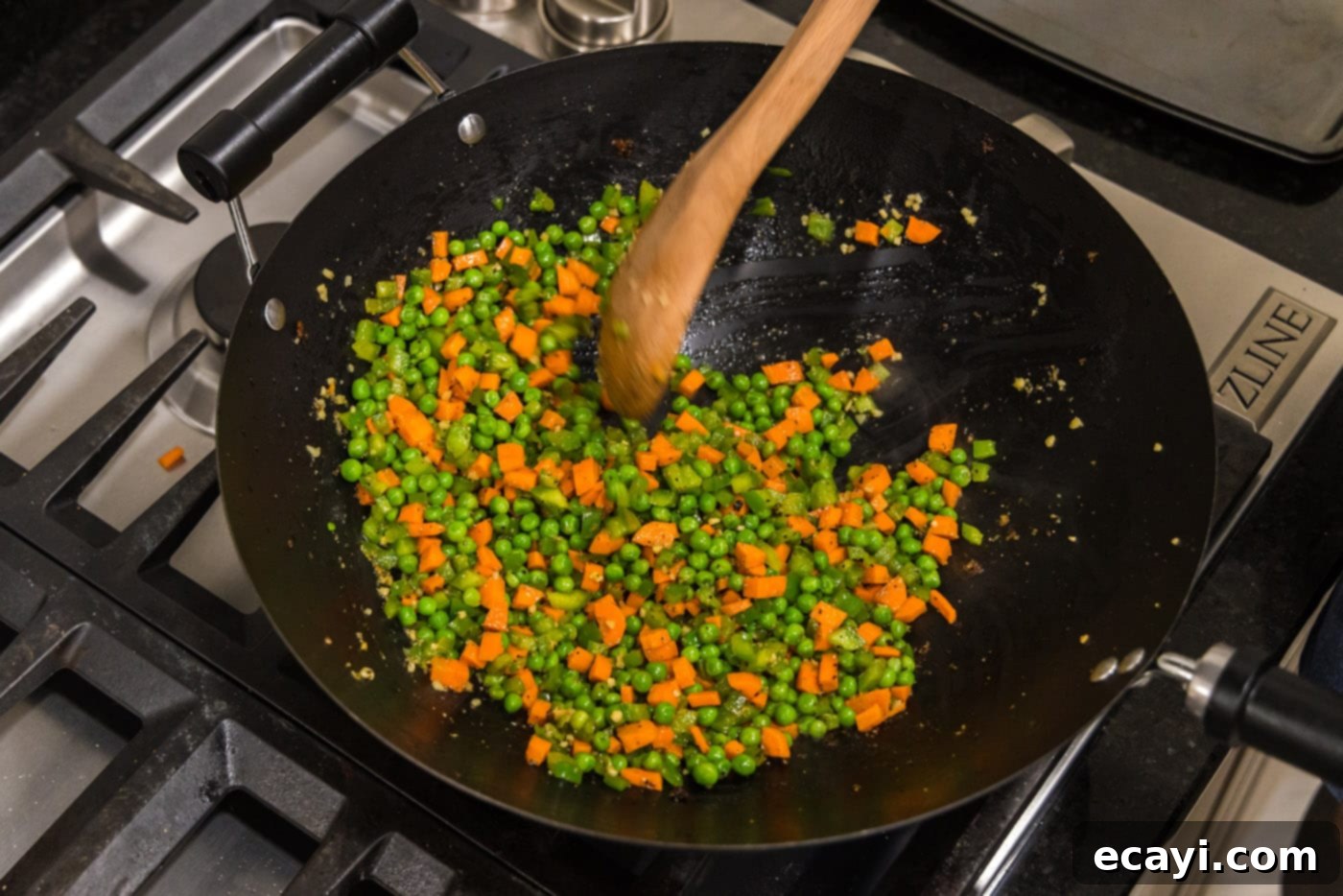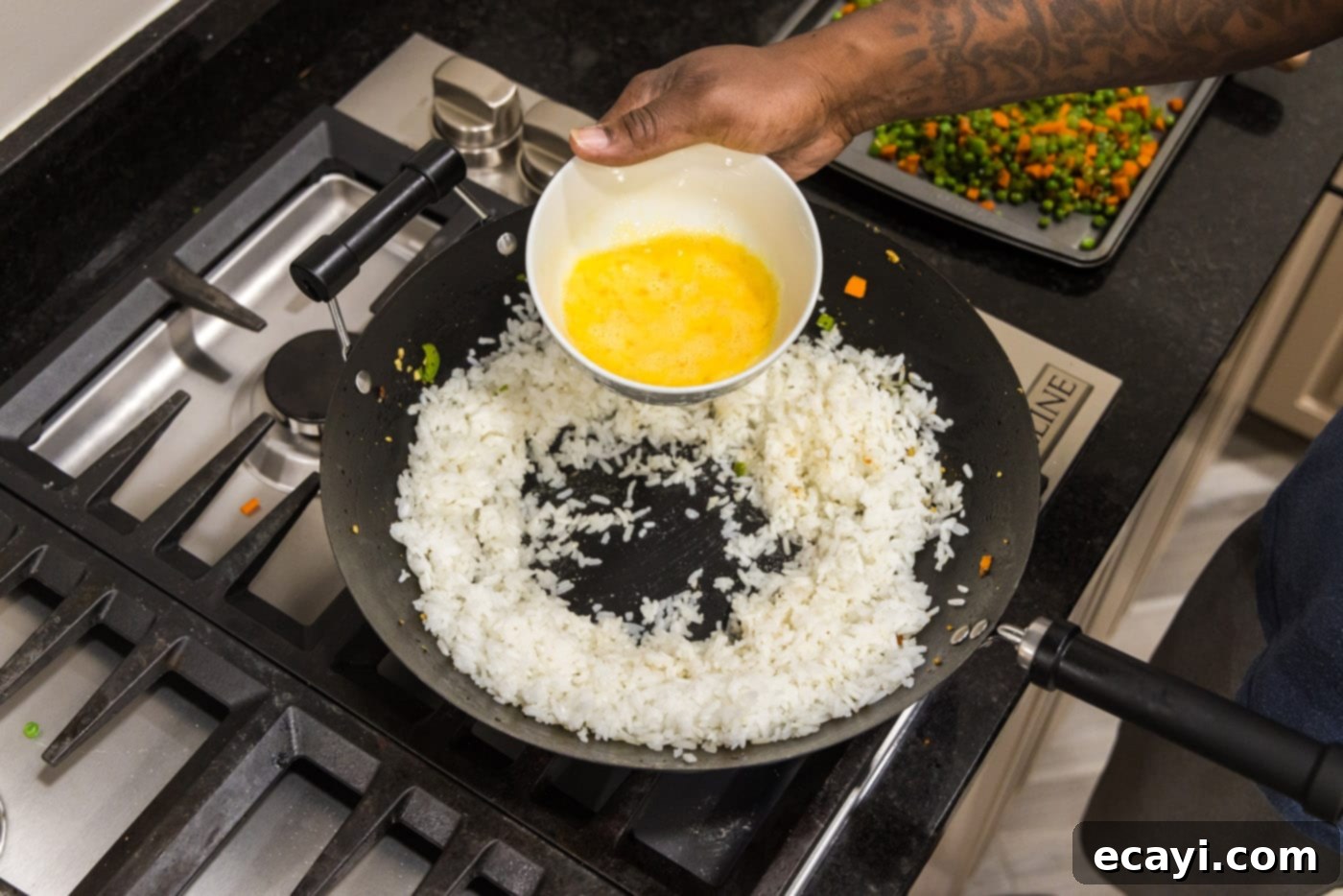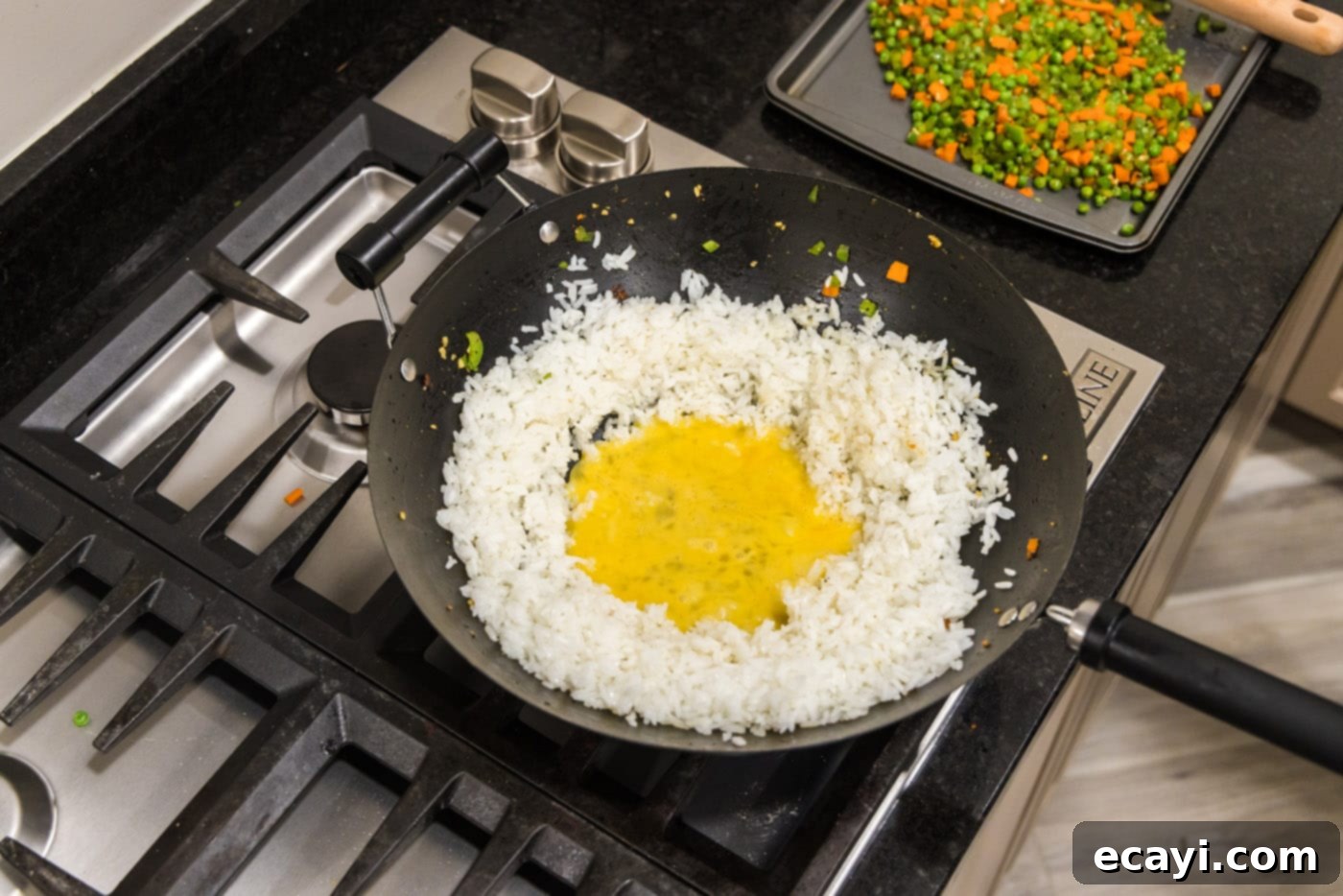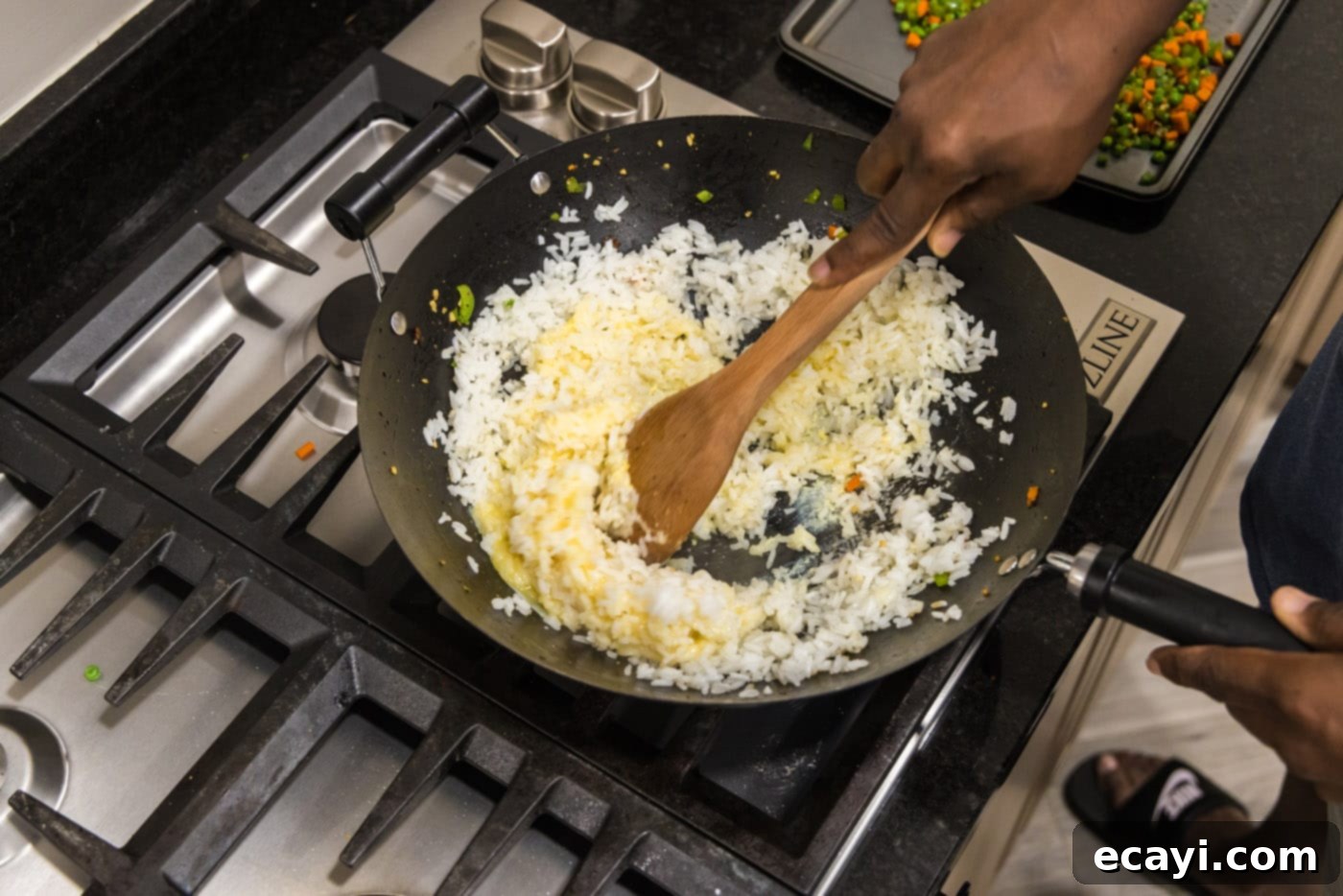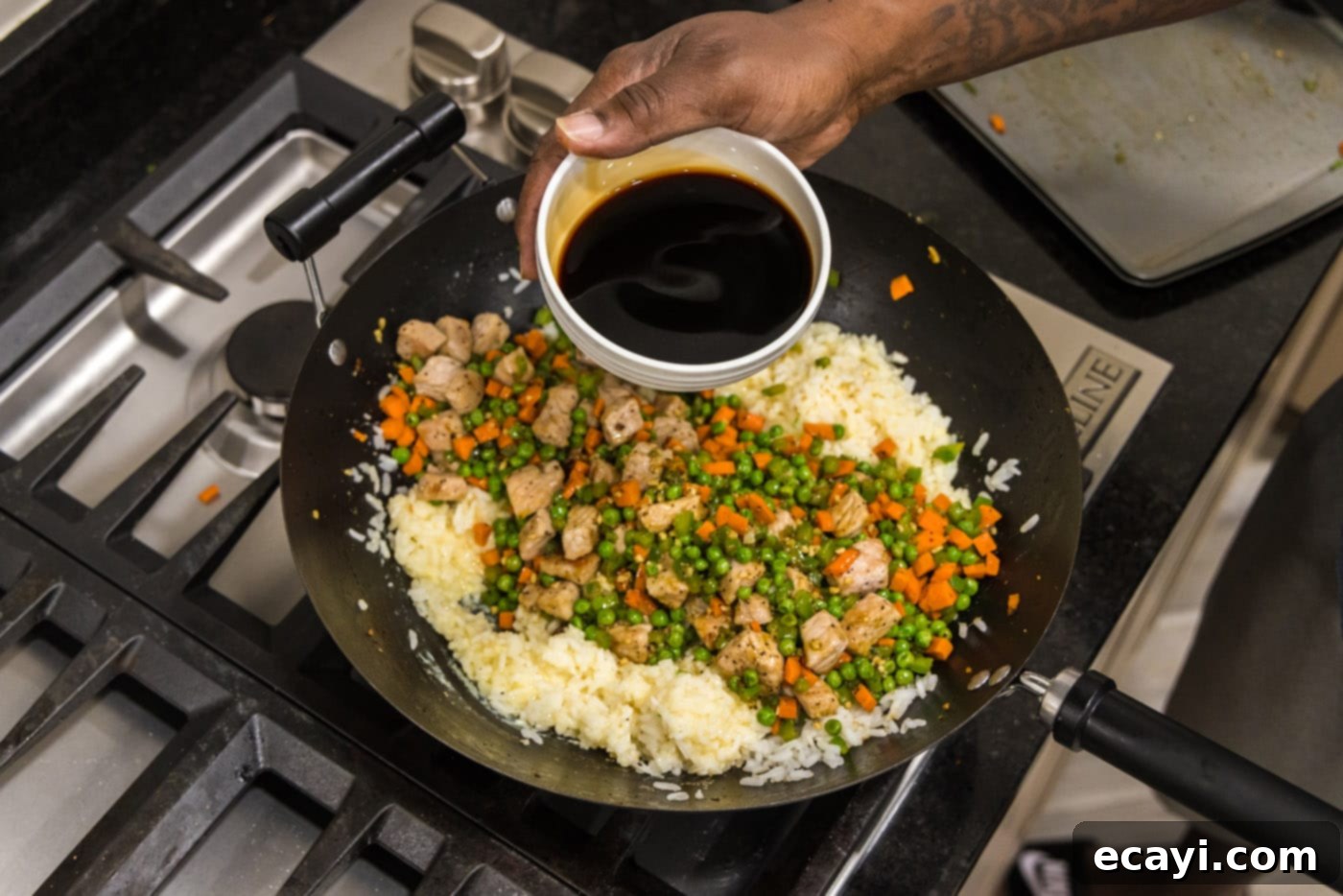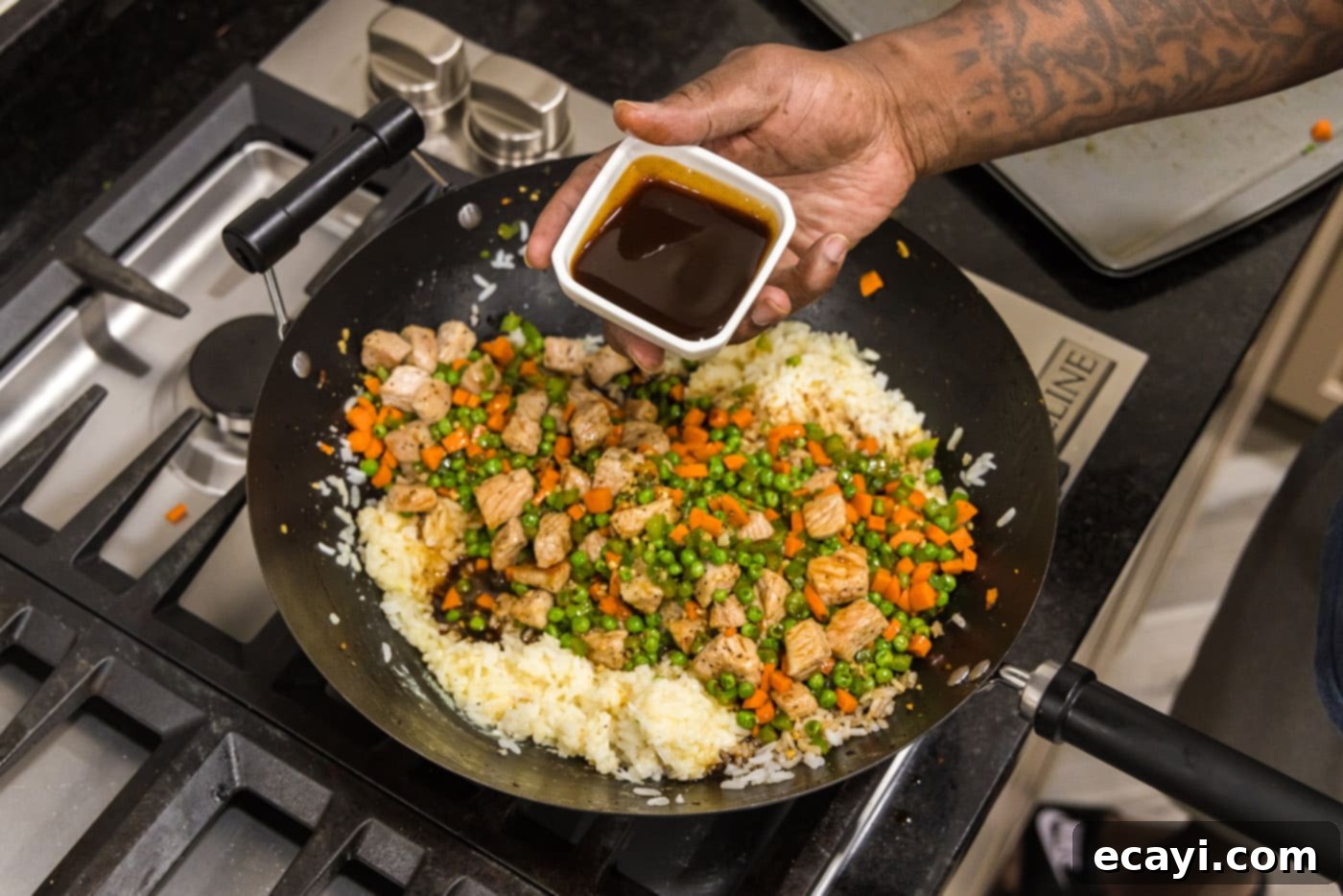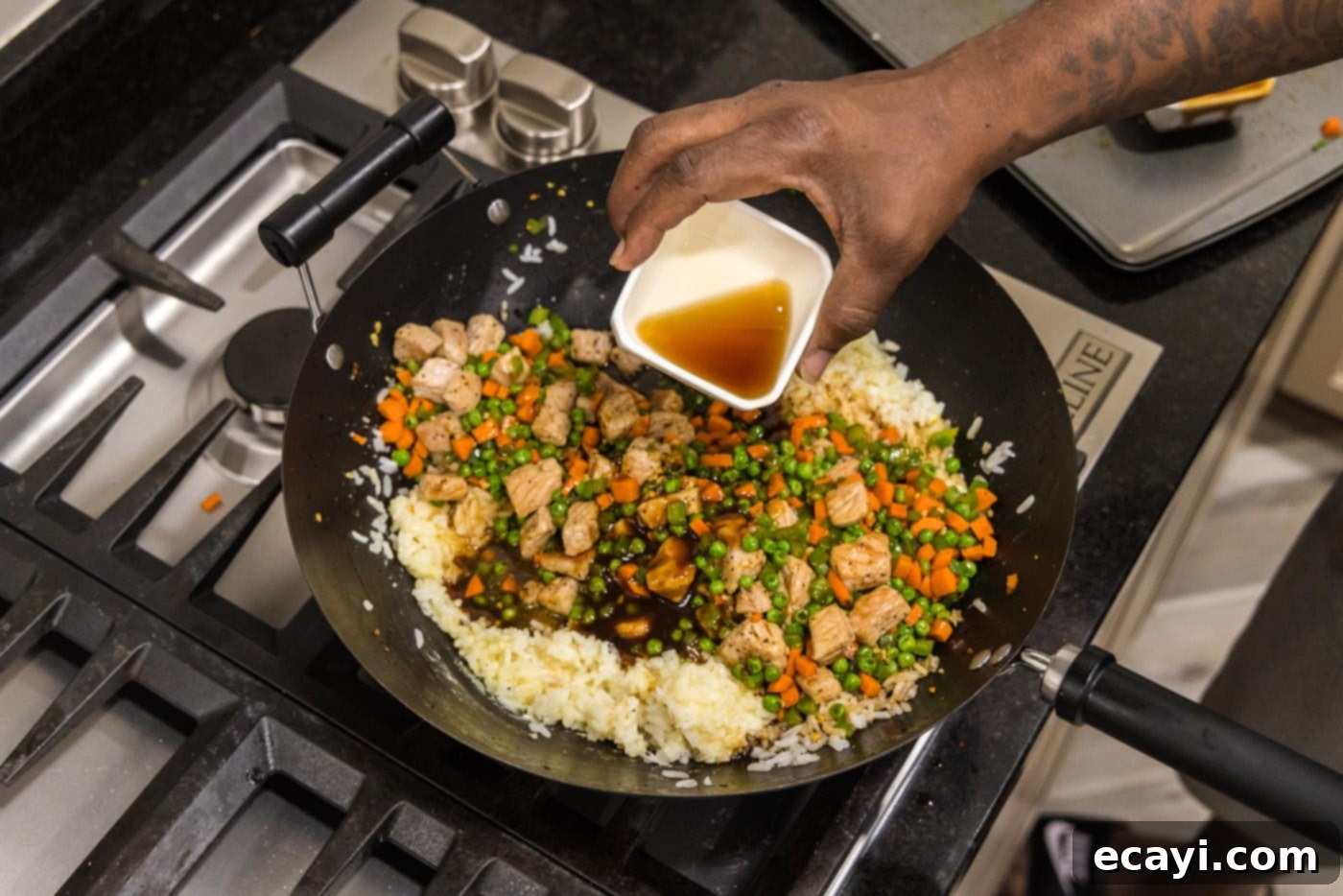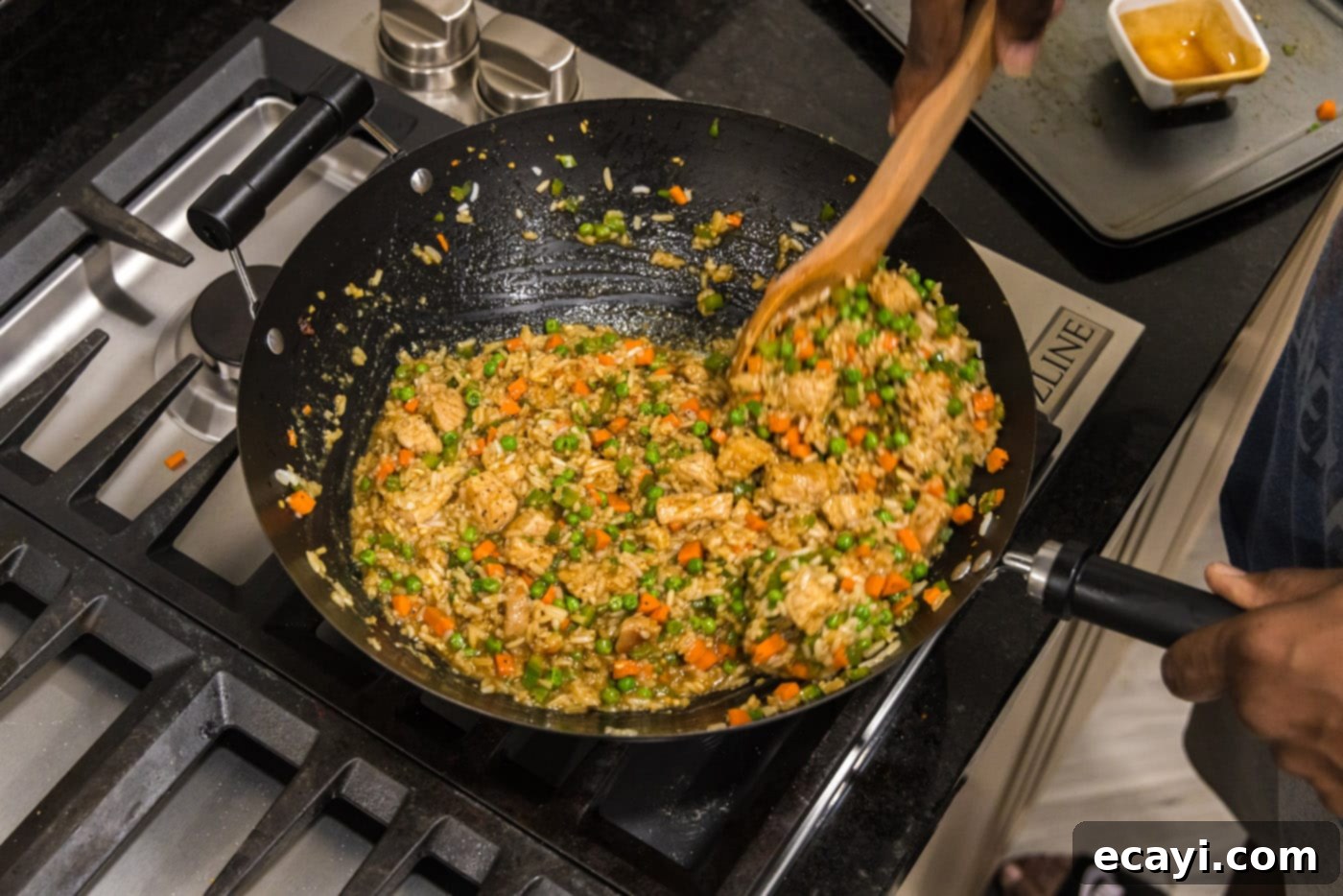Easy & Flavorful Pork Fried Rice: Your Ultimate Guide to a Quick Homemade Stir-Fry
Transform simple ingredients into an incredibly satisfying meal with this amazing pork fried rice recipe! Featuring tender boneless pork chops, vibrant bell peppers, crisp carrots, sweet peas, and aromatic ginger, all combined with perfectly cooked white rice and a savory sauce, this dish is a true crowd-pleaser. Forget takeout; your new favorite homemade fried rice is just minutes away, offering an authentic flavor profile that’s both easy to achieve and wonderfully customizable.
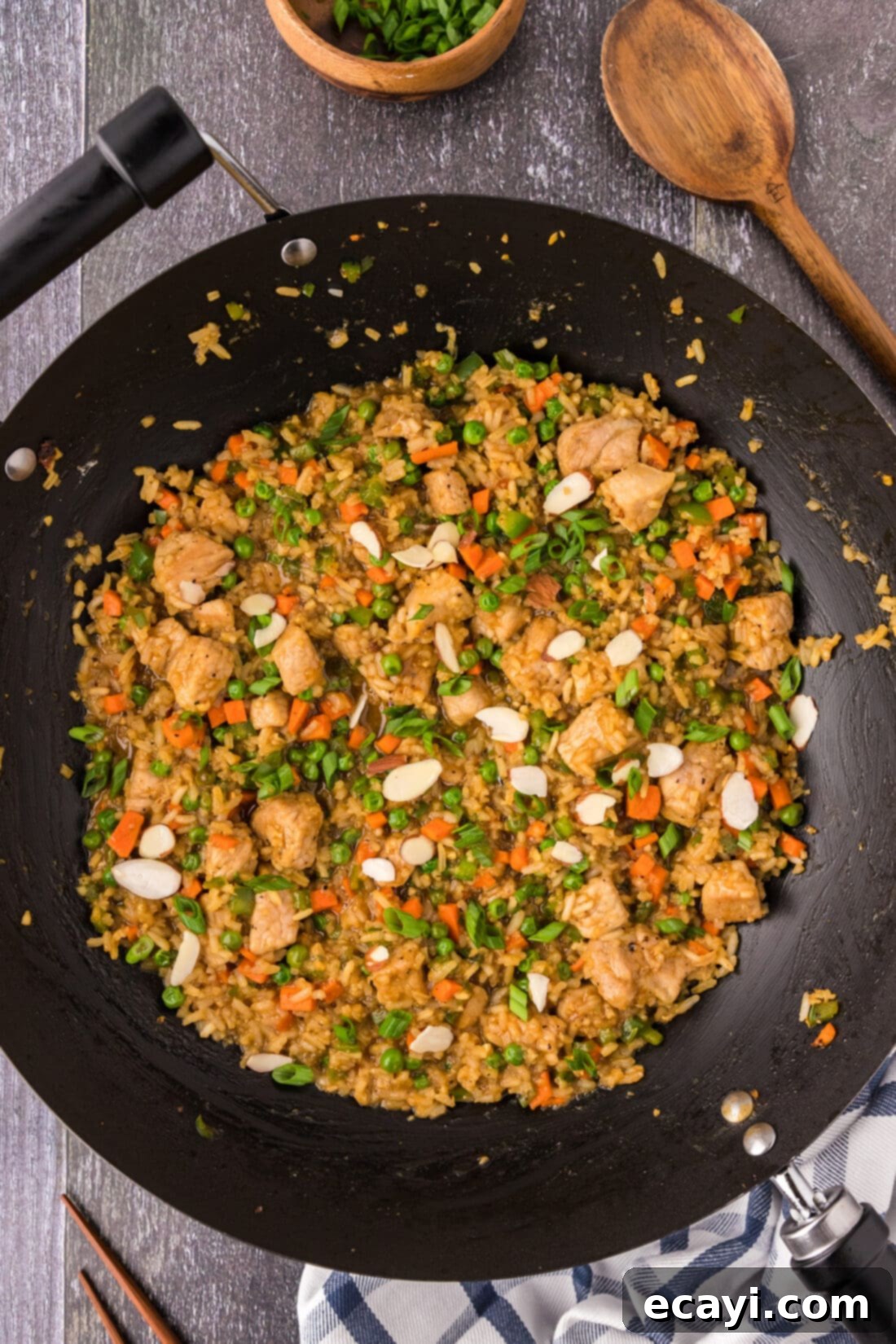
Why This Homemade Pork Fried Rice Recipe Is a Must-Try
This pork fried rice isn’t just another dinner recipe; it’s a culinary triumph you can achieve in your own kitchen with minimal effort. Here’s why it’s destined to become a staple in your meal rotation:
- Incredibly Quick & Easy: Designed for efficiency, this recipe comes together rapidly in a single skillet or wok, making it perfect for busy weeknights when you need a delicious meal on the table fast. From prep to plate, you can expect to be serving this flavorful dish in under 30 minutes.
- Bursting with Authentic Flavor: The carefully balanced combination of pungent fresh garlic, spicy ginger paste, umami-rich soy sauce, and savory oyster sauce creates a complex, irresistible flavor profile that elevates every bite. The fresh vegetables add a delightful crunch and natural sweetness, complementing the tender pork beautifully.
- Highly Customizable: This recipe provides a fantastic foundation for experimentation, allowing you to tailor it to your personal preferences or what you have available. Easily swap out or add your favorite vegetables, adjust the protein, or tweak the seasonings to suit your palate. It’s as versatile as our popular chicken fried rice, so feel free to use chicken, shrimp, beef, or even plant-based proteins like tofu as alternatives to pork.
- Perfect for Utilizing Leftovers: A fantastic way to give new life to leftover rice, this recipe transforms day-old grains into a delightful, non-mushy fried rice. The slightly dried-out texture of chilled rice is ideal for stir-frying, ensuring maximum flavor absorption and that desirable, separate grain texture.
- Better Than Takeout: Achieve authentic, restaurant-quality results at home, often healthier and always fresher than what you’d get from a local establishment. You control the ingredients, meaning no artificial additives and less sodium if you choose low-sodium soy sauce.
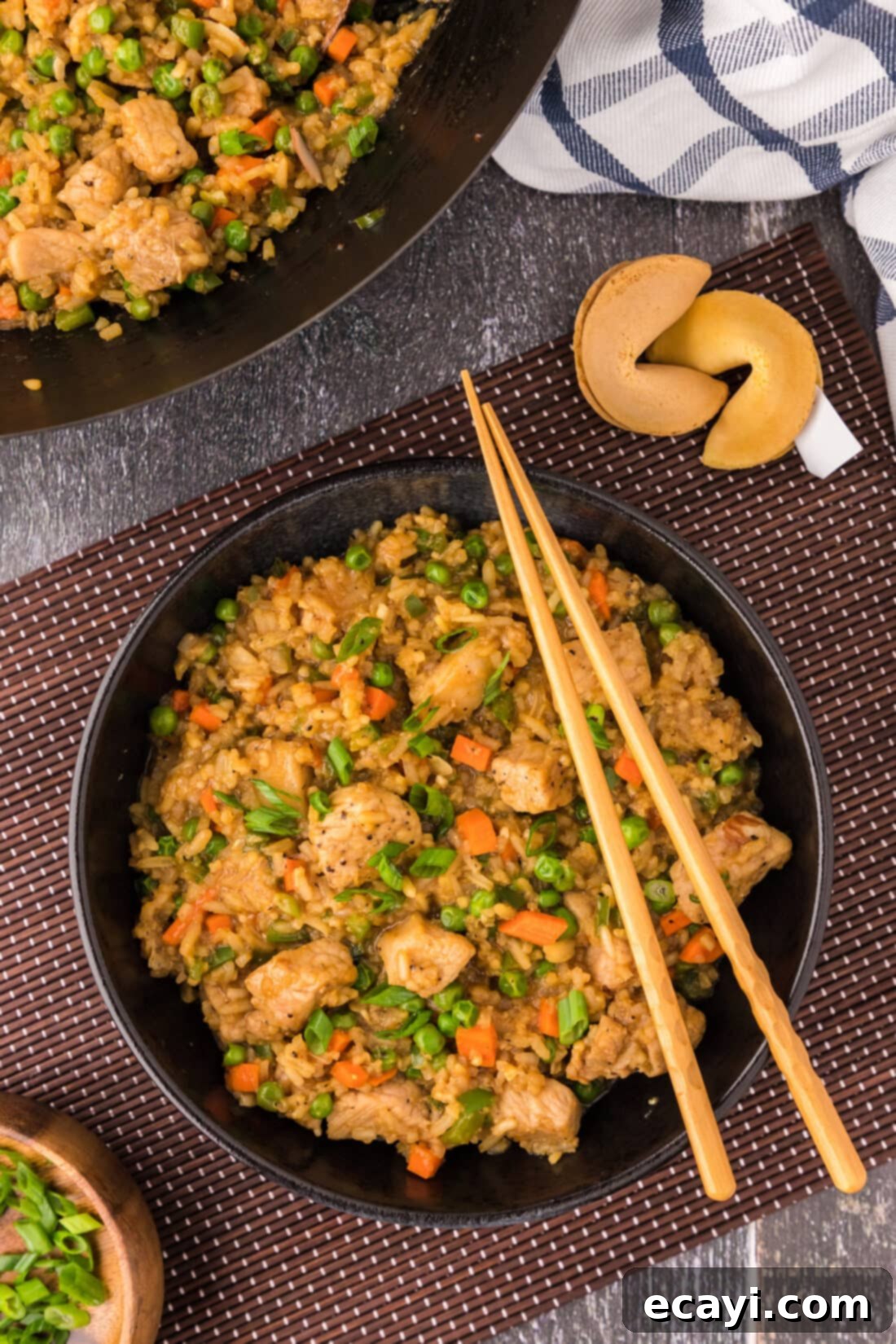
Essential Ingredients for Your Pork Fried Rice
Gathering your ingredients is the first step to creating this mouthwatering dish. Each component plays a vital role in building the layered flavors and appealing textures of this fried rice. You’ll find all precise measurements, ingredient details, and comprehensive cooking instructions in the printable recipe card at the very end of this post.
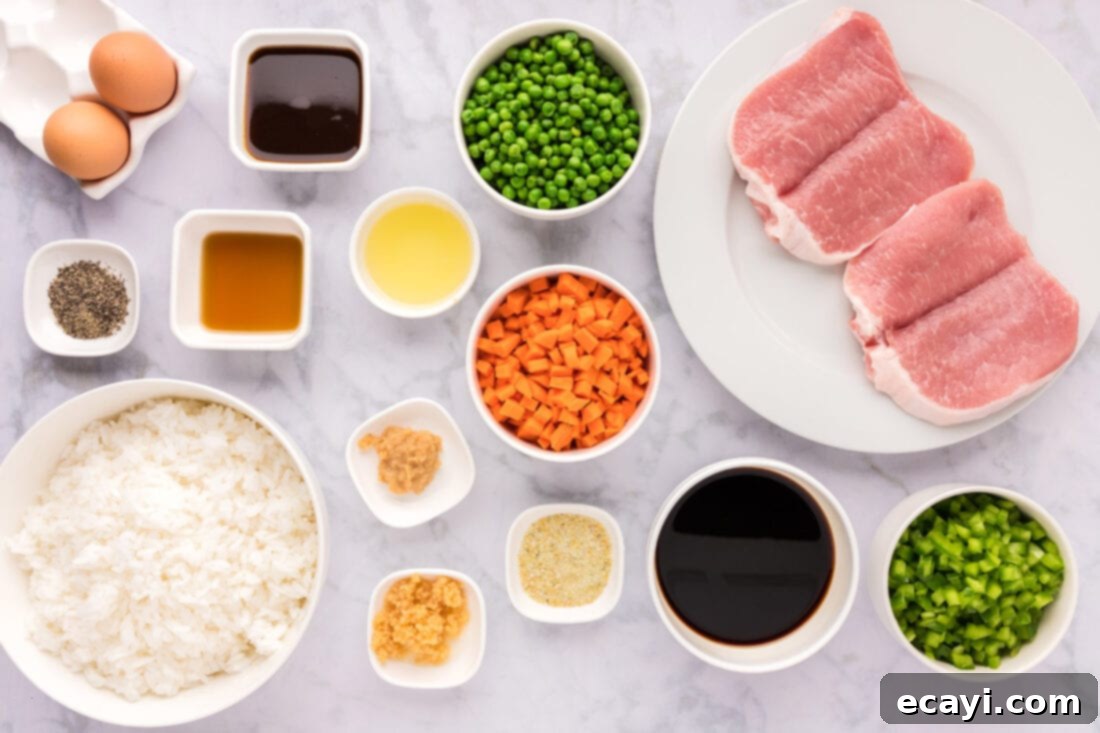
Ingredient Breakdown & Smart Substitutions
Understanding each component and its role can help you master this recipe and adapt it to your preferences or what you have on hand, ensuring delicious results every time.
PORK: For this recipe, we’ve opted for versatile boneless pork chops, cut into uniform, bite-sized pieces. This cut cooks quickly and stays tender. However, you can use almost any pork cut you prefer. Pork tenderloin is a lean and tender alternative that also cooks rapidly when diced. Ground pork offers a different, crumbly texture and cooks even faster, making it an excellent choice for a truly speedy meal. If you happen to have leftover cooked pork (like roasted pork loin or pulled pork) from a previous meal, simply dice or shred it and add it towards the end of the stir-frying process, only needing to heat through. Ensure your chosen pork is cut into uniform, small pieces, ideally around ½-inch cubes, for even cooking in the hot wok or skillet.
RICE: The absolute secret to perfect fried rice lies in using cooked white rice that is preferably day-old and thoroughly chilled. When rice sits in the refrigerator, it dries out and undergoes a process called retrogradation. This crucial step makes the starch grains firmer and less likely to clump together or become mushy when stir-fried. The result is that desirable, slightly chewy, and perfectly separate grain texture that defines great fried rice. If you don’t have leftover rice, don’t fret! You can still make this dish. Cook fresh rice, then immediately spread it thinly on a baking sheet. Refrigerate or even freeze it for 15-20 minutes to cool and dry it out as much as possible before cooking. Long-grain white rice varieties, such as jasmine or basmati, are excellent choices for their texture and aromatic qualities.
VEGETABLES: Our vibrant mix for this recipe includes sweet peas, crisp green bell peppers, and tender carrots, providing a fantastic balance of color, texture, and natural sweetness. But don’t limit your creativity! This recipe is incredibly adaptable to whatever vegetables you have on hand or prefer. Consider adding finely diced yellow onion, thinly sliced mushrooms, crunchy broccoli florets, fresh snap peas, sweet corn kernels, crispy water chestnuts, or even baby corn. The key is to cut all vegetables into similar, small sizes to ensure they cook evenly and quickly in the wok, retaining a pleasant tender-crisp texture. While fresh vegetables are generally preferred for their superior texture, thawed and well-drained frozen vegetables can also be used effectively.
EGGS: Two large eggs, whisked until light and fluffy, add a rich texture and a significant protein boost to the fried rice. They are quickly cooked directly in the wok and then mixed back in with the other ingredients, creating little pockets of fluffy scrambled egg throughout the dish, contributing to its classic appeal.
AROMATICS & SAUCES: The flavor foundation of this fried rice is built upon these essential components:
- Garlic Salt & Black Pepper: These foundational spices are used to season both the pork and the vegetables, building crucial layers of flavor from the very beginning. Adjust the quantities to your personal taste preference.
- Olive Oil: A neutral cooking oil with a relatively high smoke point is essential for effective stir-frying. Other suitable alternatives include vegetable oil, canola oil, or avocado oil.
- Minced Garlic & Ginger Paste: These fresh aromatics are absolutely non-negotiable for achieving that authentic, pungent fried rice flavor. While freshly minced garlic and grated ginger are always ideal, high-quality pre-minced garlic and ginger paste offer a convenient shortcut without sacrificing too much of that vibrant flavor.
- Soy Sauce: The backbone of most Asian stir-fries, soy sauce contributes significant umami and saltiness. Opt for a good quality light soy sauce or choose a low-sodium version if you are monitoring your salt intake.
- Oyster Sauce: This ingredient is crucial for providing a unique umami depth, a slight sweetness, and a glossy, savory glaze that is characteristic of many classic fried rice dishes. If you are vegetarian or have a shellfish allergy, an excellent vegetarian mushroom-based “oyster” sauce is readily available.
- Sesame Oil: Added sparingly at the very end of the cooking process, a drizzle of toasted sesame oil imparts a distinctive nutty aroma and a final layer of rich flavor, truly making the dish sing.
Simple Steps to Making Perfect Pork Fried Rice
These step-by-step photos and detailed instructions are provided to help you visualize each stage of the recipe, ensuring your success. For a convenient printable version, complete with precise measurements and comprehensive instructions, simply Jump to Recipe at the bottom of this page.
- Prepare the Pork: Begin by trimming any excess fat from your boneless pork chops. Then, meticulously cut the pork into uniform, small bite-sized cubes, aiming for pieces roughly ½-inch in size. Season these pork pieces generously with a portion of the garlic salt and black pepper (you’ll reserve the remaining seasoning for the vegetables later). Toss well to coat and set the seasoned pork aside.

- Whisk the Eggs: In a small bowl, crack the two large eggs and whisk them vigorously until the yolks and whites are fully combined and slightly frothy. This ensures a uniform distribution when added to the rice. Keep this bowl nearby, ready for when you need it.

- Cook the Pork: Heat 1 tablespoon of olive oil in a large wok or a spacious skillet over medium-high heat. Allow the oil to become shimmering hot before adding the seasoned pork cubes. Stir-fry the pork, tossing frequently, until it is fully cooked through, showing no pink, and has developed a slight golden-brown sear on the edges. This typically takes about 4-6 minutes, depending on the heat level and the size of your pork pieces. Once cooked, remove the pork from the wok and transfer it to a clean plate, setting it aside.


- Sauté the Vegetables: Add another 1 tablespoon of olive oil to the same wok over medium-high heat (there’s no need to wash the wok). Once the oil is hot, add the diced green bell pepper, diced carrots, thawed frozen peas, minced garlic, ginger paste, the remaining black pepper, and the remaining garlic salt. Stir-fry these vibrant vegetables for 3-4 minutes, tossing continuously, until they are tender-crisp – you want them slightly softened but still retaining a delightful bite. Transfer the cooked vegetable mixture from the pan to a separate bowl and set aside with the pork.


- Cook the Rice and Eggs: Add the final 1 tablespoon of olive oil to the now-empty wok. Introduce the cooked white rice to the hot pan, using your spoon or spatula to break up any clumps. Toss the rice frequently to warm it through and lightly toast the grains for about 1-2 minutes. Next, push the rice to one side of the wok, creating a clear well in the center. Pour the whisked eggs into this well. Allow them to set slightly, then gently scramble the eggs directly within the well until they are cooked through and fluffy. Once scrambled, thoroughly mix the cooked egg into the rice.



- Combine & Sauce: Return the cooked pork and the stir-fried vegetable mixture to the wok with the rice and scrambled egg. Pour the soy sauce, oyster sauce, and sesame oil evenly over all the ingredients in the wok.



- Finish & Serve: Stir everything together thoroughly and vigorously, ensuring the savory sauce coats every single grain of rice and every piece of pork and vegetable. Continue to stir-fry for another 1-2 minutes until all ingredients are well combined, heated through, and the flavors have melded beautifully. Serve your delicious homemade pork fried rice immediately, perhaps garnished with fresh green onions or a sprinkle of toasted sesame seeds for an extra touch of flavor and visual appeal.

Frequently Asked Questions & Expert Tips for the Best Fried Rice
Once your pork fried rice has cooled to room temperature, transfer any leftovers into an airtight container. Store it promptly in the refrigerator, where it will remain fresh for up to 3 days. For the best texture when reheating, stir-fry it in a hot pan with a tiny bit of oil until thoroughly warmed through, avoiding the microwave if possible to maintain the crispy texture.
Using day-old, chilled rice is highly recommended for fried rice because it has a significantly lower moisture content compared to freshly cooked rice. This reduction in moisture is crucial; it prevents the rice from clumping together and becoming mushy when stir-fried, allowing the individual grains to achieve that perfectly separate, slightly crispy texture characteristic of authentic fried rice. The scientific process of starch retrogradation, where starches firm up upon cooling, is key here. While leftover rice is ideal, you can still use freshly cooked rice if necessary; just be sure to spread it out thinly on a tray to cool and dry as much as possible before adding it to the wok.
A large, traditional wok is generally preferred for stir-frying due to its sloped sides and ability to distribute high heat quickly and evenly. This design allows for easy tossing of ingredients and ensures they cook rapidly without steaming. However, if you don’t own a wok, a large, heavy-bottomed skillet (such as a cast iron skillet or a high-quality stainless steel pan) will also work wonderfully. The key is to use a pan that can hold and maintain high heat and is large enough to avoid overcrowding the ingredients, which is vital for proper stir-frying.
Absolutely! This pork fried rice recipe is incredibly versatile and encourages customization. Feel free to swap the pork for other proteins like diced chicken breast or thighs, succulent shrimp, thinly sliced beef, or even plant-based options like firm tofu or edamame. For vegetables, don’t hesitate to experiment with finely diced yellow onion, sliced mushrooms, crisp broccoli florets, tender baby corn, water chestnuts, or even a handful of fresh spinach added at the very end. Just remember to cut all ingredients into similar small sizes to ensure they cook evenly and quickly.
To achieve perfectly non-greasy, non-sticky fried rice, several tips are essential. Firstly, use just enough oil to coat the pan; excessive oil leads to greasiness. Secondly, cook your ingredients in stages, especially the pork and vegetables, and avoid overcrowding your wok or skillet. Overcrowding lowers the pan’s temperature and causes ingredients to steam in their own juices rather than fry, leading to a mushy and often greasy result. Ensure your heat is consistently high throughout the stir-frying process. If you notice any excess oil pooling, you can gently blot it away with a paper towel before adding new ingredients, or simply adjust your oil usage in subsequent steps.
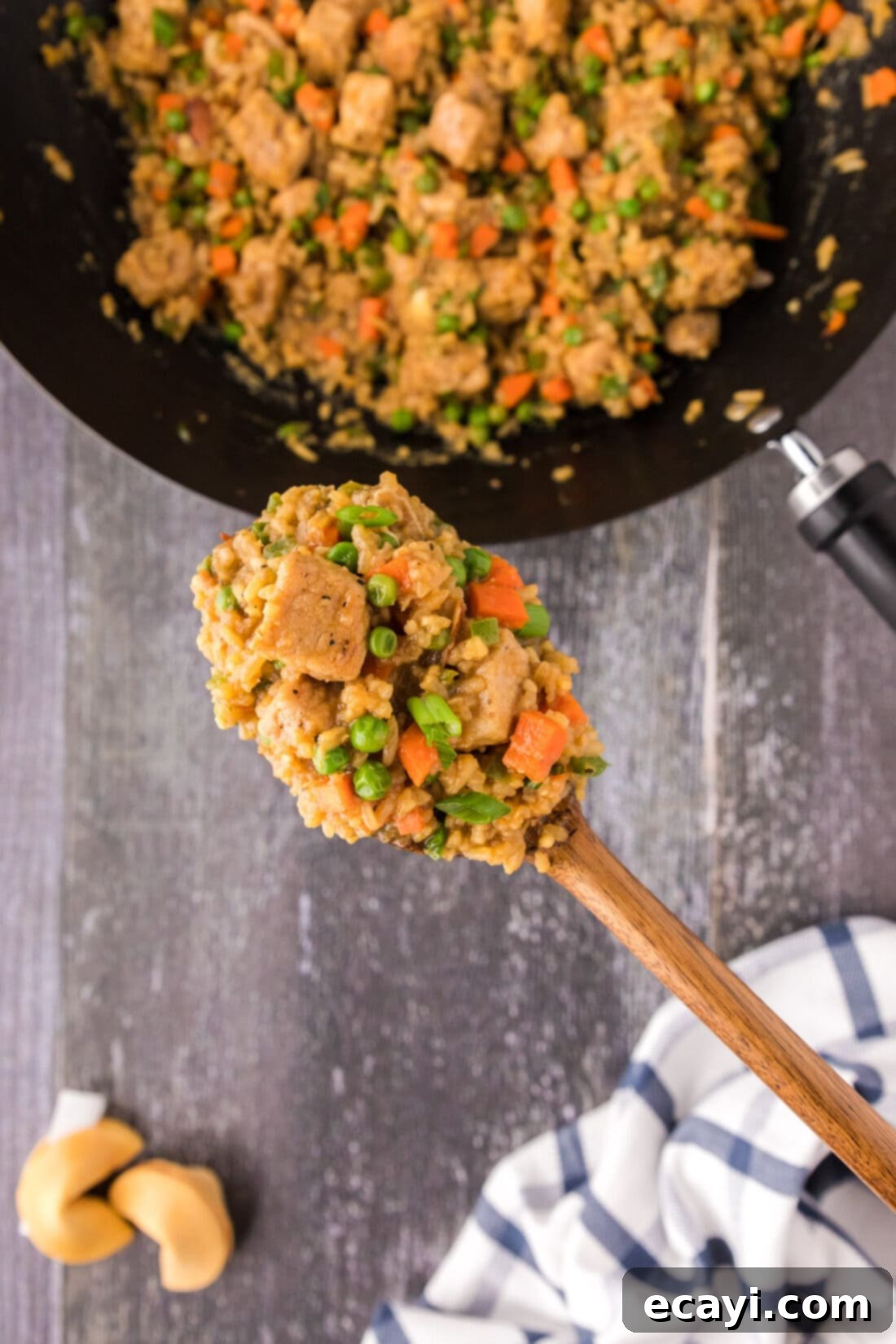
Delicious Serving Suggestions for Pork Fried Rice
While pork fried rice is hearty and flavorful enough to stand alone as a complete meal, it also makes a wonderful centerpiece or side dish for a larger Asian-inspired feast. Enhance your dining experience and create a truly memorable meal with these complementary options:
- Soups: A light and comforting bowl of Egg Drop Soup or a zesty Hot and Sour Soup would be perfect to start your meal, offering a refreshing contrast to the richness of the fried rice.
- Appetizers: Pair your fried rice with classic Asian appetizers such as crispy vegetable spring rolls, savory egg rolls, steamed or pan-fried dumplings, flavorful potstickers, or even a refreshing cucumber salad for a lighter touch.
- Main Dishes: Elevate your meal by serving the fried rice alongside other popular Asian takeout favorites. Think General Tso’s Chicken, succulent Beef and Broccoli, or a sweet and tangy Sweet and Sour Pork for a grand and varied spread.
- Garnish: For an extra touch of freshness, flavor, and visual appeal, generously garnish your homemade fried rice with freshly chopped green onions (scallions), a sprinkle of toasted sesame seeds for a nutty crunch, or even thinly sliced toasted almonds.
More Irresistible Asian-Inspired Recipes
If you loved this pork fried rice and are looking for more quick, flavorful, and easy Asian-inspired dishes to add to your repertoire, you’re in for a treat! Explore more delicious and fuss-free recipes from our extensive collection:
- Flavorful Chicken Fried Rice
- Healthy Cauliflower Fried Rice (Low Carb Option)
- Speedy Teriyaki Chicken and Rice
- One-Skillet Chicken, Broccoli, and Rice
- Quick & Easy Shrimp Fried Rice
I’m passionate about cooking and baking, and I love sharing my culinary adventures and tested recipes with all of you! To make sure you never miss a new dish, I offer a convenient newsletter delivered straight to your inbox every time a new recipe is posted. Simply subscribe here and start receiving your free daily recipes, tips, and inspiration directly from my kitchen to yours!
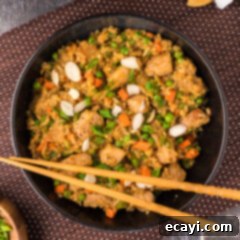
Flavorful Homemade Pork Fried Rice
IMPORTANT – Don’t miss our Frequently Asked Questions and Expert Tips sections within the blog post for even more helpful information and insights to perfect your fried rice!
Print It
Pin It
Rate It
Save ItSaved!
Ingredients
- 1 pound boneless pork chops cut into ½-inch cubes
- ½ Tablespoon garlic salt divided
- 1 teaspoon black pepper divided
- 2 large eggs
- 3 Tablespoons olive oil divided
- 1 cup diced green bell pepper
- 1 cup diced carrots
- 1 cup frozen peas (thawed)
- 1 Tablespoon minced garlic
- 2 Tablespoons ginger paste
- 2 ½ cups cooked white rice (preferably day-old and chilled)
- ¾ cup soy sauce (low sodium optional)
- 3 Tablespoons oyster sauce (or vegetarian alternative)
- 2 Tablespoons sesame oil
Tools You’ll Need
-
Wok or large skillet
-
Wooden spoon or spatula
-
Cutting board and knife
Helpful Recipe Notes & Expert Tips
- Vegetable Versatility: While our recipe calls for peas, green bell peppers, and carrots, feel free to get creative! Add chopped yellow onion, sliced mushrooms, broccoli florets, or even snow peas. Just ensure all vegetables are cut into similar, small pieces for even cooking in the hot wok or skillet.
- Rice is Key for Texture: For the best fried rice texture, we highly recommend using day-old, chilled cooked white rice. The reduced moisture prevents mushiness and helps achieve those perfectly separate, slightly crispy grains that are characteristic of excellent fried rice. If you’re using freshly cooked rice, spread it out on a baking sheet to cool and dry for 15-20 minutes before stir-frying.
- Pork Alternatives: Don’t have boneless pork chops on hand? No problem! Pork tenderloin will offer a leaner, quick-cooking option when diced, while ground pork works exceptionally well for a different, crumbly texture. Even leftover cooked pork can be diced or shredded and added at the end to simply heat through.
- Storage: Store any leftover pork fried rice in an airtight container in the refrigerator for up to 3 days. For optimal taste and texture when reheating, gently stir-fry it in a hot skillet rather than microwaving.
- High Heat is Your Friend: Effective stir-frying demands high heat. Ensure your wok or skillet is very hot before adding any ingredients, and be careful not to overcrowd the pan. High heat allows ingredients to fry quickly and develop caramelized flavors, preventing them from steaming and becoming soggy. Cook in batches if necessary to maintain consistent high temperature.
Instructions
-
Trim any excess fat from the pork chops and cut them into uniform bite-sized pieces (about ½-inch cubes). Season the pork with half of the garlic salt and half of the black pepper, tossing well to coat. Set the seasoned pork aside.
-
In a small bowl, whisk the two large eggs until well combined and slightly frothy. Set aside, ready for use.
-
Heat 1 tablespoon of olive oil in a large wok or skillet over medium-high heat until it shimmers. Add the seasoned pork cubes and stir-fry, tossing frequently, until no pink remains and the pork is lightly browned and cooked through (this usually takes 4-6 minutes). Remove the cooked pork from the wok and set it aside on a clean plate.
-
Add another 1 tablespoon of olive oil to the same wok. Add the diced green bell pepper, diced carrots, thawed frozen peas, minced garlic, ginger paste, the remaining garlic salt, and remaining black pepper. Stir-fry these vegetables for 3-4 minutes, until they are tender-crisp. Remove the vegetable mixture from the pan and set it aside with the pork.
-
Add the final 1 tablespoon of olive oil to the wok. Add the cooked white rice, breaking up any clumps with your utensil, and toss it to warm through for 1-2 minutes. Push the rice to one side to create a well in the center of the wok. Pour the whisked egg into this well and quickly scramble it. Once cooked, thoroughly mix the scrambled egg into the rice.
-
Return the cooked pork and stir-fried vegetables to the wok with the rice and egg. Pour in the soy sauce, oyster sauce, and sesame oil evenly over all the ingredients. Stir everything together thoroughly, ensuring all ingredients are evenly coated with the savory sauce. Continue to stir-fry for 1-2 minutes to heat all components through and allow the flavors to meld. Serve immediately for the best experience.
Nutrition Information
The recipes on this blog are meticulously tested using a conventional gas oven and a gas stovetop to ensure consistent and reliable results. Please be aware that cooking appliances, especially as they age, can sometimes cook inconsistently. We recommend using an inexpensive oven thermometer to verify that your oven is accurately reaching the desired temperature. For those using toaster ovens or countertop ovens, please note that heat distribution may differ from full-sized conventional ovens, and cooking or baking times may require adjustment. When recipes specify a pressure cooker, air fryer, slow cooker, or other specialized appliance, links to the specific models we use are provided within the respective recipe sections for your convenience. For baking recipes where ingredients are measured by weight, using volume measurements (cups) instead may yield different results, and we cannot guarantee success with such alterations.
